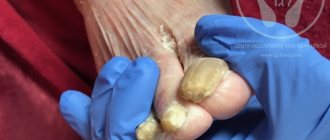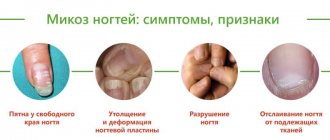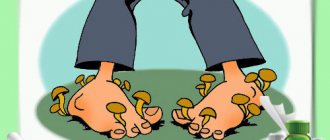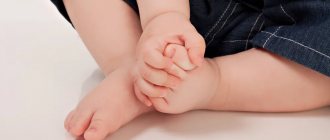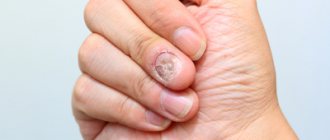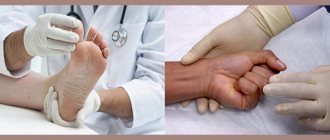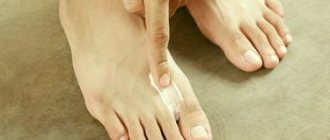Onychomycosis is a fungal infection of the nail plates. The disease is caused by dermatophyte fungi, microsporia and others.
Nail fungus is very common. According to doctors, it affects more than 20% of the entire population of the planet, while this disease is diagnosed much less frequently (less than 3% of patients). This difference in percentage is explained by the fact that nail fungus is not life-threatening. Therefore, not everyone turns to a specialist for treatment of onychomycosis, hoping to cure themselves or ignoring the problem.
Table of contents
- Etiology and pathogenesis
- Clinical manifestations
- Principles of treatment
Onychomycosis (fingernail fungus, toenail fungus) is a fungal infection of the toenails or fingernails that affects any component of the nail complex, including the base, bed or plate. The disease can be accompanied by pain, discomfort, and changes in the appearance of the nails, which in some cases leads to serious physical and professional limitations, anxiety for patients and a decrease in their quality of life.
In our company you can purchase the following equipment for the treatment of onychomycosis:
- AcuPulse (Lumenis)
In the USA, onychomycosis of the nails occurs in approximately 2–13% of the population, in Canada - in 6.5%, in England, Spain and Finland - in 3-8%. According to a systematic review of 1914 articles, the prevalence of onychomycosis is as follows:
- general population - 3.22%;
- children - 0.14%;
- elderly people - 10.28%;
- patients with diabetes mellitus - 8.75%;
- patients with psoriasis - 10.22%;
- HIV-positive patients - 10.40%;
- patients on dialysis - 11.93%;
- after kidney transplant - 5.17%.
Onychomycosis accounts for about half of all nail pathologies and is the most common nail disease in adults. As for the affected areas, statistically, the legs are affected much more often than the arms.
The main forms of onychomycosis are:
- Distal lateral subungual onychomycosis
- Proximal subungual onychomycosis
- White superficial onychomycosis
- Endonyx-onychomycosis
- Candidal onychomycosis
Often patients have a combination of these subtypes, or total dystrophic onychomycosis - damage to the entire nail complex.
Treatment
Nail fungus causes more than just aesthetic discomfort. Developing in the subungual space, onychomycosis can eventually penetrate the bloodstream, spread throughout the body and cause general allergization. That is why it is necessary to begin treatment when the first signs of the disease appear and continue until complete recovery.
For successful and effective treatment of onychomycosis, it is necessary to strictly follow the prescription of a dermatologist. First of all, it is important to make a correct diagnosis.
At the MedNail clinic you can take tests at a time convenient for you and get results in the shortest possible time.
At your appointment, a dermatologist will scrape the affected area. In a special laboratory, a specialist will perform microscopy. Cultural studies are also carried out (the collected material is placed in a special nutrient medium) and the development of the fungal colony is monitored. This helps determine which species caused the disease.
Treatment of nail fungus involves cleaning off the affected part of the nail plate with a special tool and apparatus in the podiatrist’s office. Treatment with local antifungal agents will then be prescribed. In case of serious extensive lesions, the doctor will prescribe general antimycotic agents. Therapy may also be required to boost overall immunity.
Etiology and pathogenesis of onychomycosis
Onychomycosis is caused by three main classes of fungi: dermatophytes, yeasts, and nondermatophytic molds.
Dermatophytes are the most common cause of the disease. Two main pathogens are responsible for 90% of all cases of onychomycosis: Trichophyton rubrum (70%) and Trichophyton mentagrophytes (20%). Onychomycosis, caused by non-dermatophytic mold fungi of the genera Fusarium and Aspergillus, as well as Scopulariopsis brevicaulis, is an anamorphic (asexual) representative of the genus Ascomycota, is gradually spreading throughout the world. Today they are responsible for 10% of cases of the disease. As for candidal onychomycosis, it is caused by Candida albicans and is quite rare.
In distal lateral subungual onychomycosis, Trichophyton rubrum is usually detected. Proximal subungual onychomycosis is typical in immunocompromised patients . The same type of onychomycosis, but with periungual inflammation, is caused by non-dermatophytic molds. White superficial onychomycosis of the nails is caused by Trichophyton mentagrophytes, and its deeper forms are caused by non-dermatophytic molds. Candida nail infection is often observed in premature infants, immunocompromised patients, and individuals with chronic mucosal candidiasis.
Risk factors for developing onychomycosis:
- family history;
- elderly age;
- warm and humid climate;
- weakened body;
- nail injury;
- regular fitness classes;
- immunosuppression (drug, HIV, etc.);
- visiting public swimming pools, baths and saunas;
- tight shoes.
Repeated microtrauma of the nails in tight and uncomfortable shoes provokes onycholysis (detachment of the nail from the soft tissues of the finger) and other degenerative conditions that contribute to the penetration of fungi into the nails.
Not necessarily a fungus
In addition to mycosis, there are many other diseases that affect the nails. Among them, it should be noted in particular onychodystrophy, psoriasis of the nail plates, eczema of the nail plates, etc. Their treatment is radically different from the treatment of fungus. To confirm and establish an accurate diagnosis of onychomycosis, it is necessary to do tests: microscopy and culture. These methods make it possible to identify the exact type of fungus: dermatophytes, mold or yeast. Now many doctors neglect this, and completely in vain. The prescription of the necessary treatment and the selection of the correct systemic therapy depend on the type of fungus.
Clinical manifestations of nail onychomycosis
At first, onychomycosis is asymptomatic - patients can see a doctor because of visible cosmetic defects of the nail plate, but without any discomfort. As the disease progresses, paresthesia, pain and discomfort occur in the affected area. This makes walking difficult and interferes with sports and everyday life.
Clinical manifestations of onychomycosis depend on its type:
- Distal lateral subungual onychomycosis - there is subungual hyperkeratosis and onycholysis, the plate becomes yellow-white. In its central part, yellow stripes and/or yellowish onycholytic areas are visible.
- Proximal subungual onychomycosis - represented by leukonychia (white spots and stripes) in the proximal parts of the nail plate, which move distally (towards the edge) as the nail grows. If mold fungi are among the pathogens, periungual inflammation occurs.
- White superficial onychomycosis - small white speckled spots form on the toenails, the nail plate becomes rough and crumbles easily. Variations are possible with a deeper spread of the pathological process into the nail, depending on the causative agent of the disease.
- Endonyx-onychomycosis - the color of the nail plate becomes milky white. Unlike distal onychomycosis, there are no signs of subungual hyperkeratosis or onycholysis.
- Candidal onychomycosis of the nails is associated with chronic mucocutaneous candidiasis or immunosuppression, in which several or all nails are affected at once with the presence of periungual inflammation. The fingers of such patients often take on the shape of a bulb or drumsticks.
To assess the severity of the disease, the Onychomycosis Severity Index (OSI) has been developed. The result is obtained by multiplying the lesion area scores by the proximity scores of the lesion to the nail growth zone. Mild degree – 1–5 points, moderate – 6–15, severe – 16–35. Dermatophytoma (spots or longitudinal stripes) more than 2 mm with subungual hyperkeratosis is scored 10 points.
In its manifestations, onychomycosis is similar to many other nail pathologies. For example, leukonychia (stripes) resemble trauma to the nail plate. To confirm the diagnosis, it is necessary to perform a laboratory mycological study. Interestingly, a negative result does not rule out onychomycosis, since microscopy can be false negative in 10% of cases and culture in 30% of cases. A more reliable, although more expensive, method is PCR research (polymerase chain reaction).
Rice. 1. Distal lateral subungual onychomycosis (Dr. Antonella Tosti)
Rice. 2. Proximal subungual onychomycosis (Dr. Antonella Tosti)
Rice. 3. White superficial onychomycosis (Dr. Antonella Tosti)
Rice . 4. Endonyx-onychomycosis (Piraccini B., Alessandrini A. Onychomycosis: A Review. J Fungi 2015; 1: 30–43)
Rice. 5. Candidal onychomycosis (Dr. Antonella Tosti)
Is it really being treated?
Today, the problem of successful therapy of mycoses can be solved. But it must be approached professionally. One of the important points: in addition to drug treatment, hardware treatment with diamond cutters is strongly recommended for patients with nail mycoses. Its essence is to remove as much as possible the part of the nail affected by the mycelium of the fungus, for better penetration of external therapy drugs and speed up recovery. It should be borne in mind that, unfortunately, neither ointments nor solutions penetrate the nail. If you do not remove several layers of the nail plate affected by mycelium, then during the growth of a healthy nail, it will be re-affected by screening from the infected part of the nail plate.
Prevention
After completing the treatment program, special attention should be paid to the subsequent prevention of the disease. Doctors recommend following simple rules that will help avoid onychomycosis infection in the future:
- Use individual shoes in saunas, swimming pools, gyms and other common areas.
- Lead a healthy lifestyle, perform procedures that strengthen the body's immune system.
- Adhere to the rules and regulations of hygiene, in particular, regularly wash your feet and hands.
Maintaining hygiene requirements is also necessary during the treatment process. Only in this case will it be possible to completely get rid of the unpleasant disease.
Possible complications
Pessimists who do not believe that onychomycosis is curable should keep in mind that, fortunately, they are mistaken. However, if the disease is ignored or self-medicated without being sure of the correct diagnosis, problems may arise.
Possible complications include:
- the occurrence of mycotic eczema with a large area affected by the fungus;
- burns caused by improper use of keratolytic plaster;
- dysfunction of the liver and gastrointestinal organs, caused by the accumulation of toxins in the body;
- the development of an allergic reaction, also occurring due to the fact that the body is “overloaded” with substances harmful to it;
- psychological problems caused by the fact that a person cannot live an ordinary life - for example, without hesitation, visit the bathhouse, go to the beach.
Information about the manifestations and treatment, classification and photos of symptoms of the Coxsackie virus in children can be found in this material.
Causes and symptoms, treatment methods and photos of carbuncles - all this is in the next article.
Reviews
Georgy, 44 years old: “When the doctor determined my diagnosis, onychomycosis, she immediately prescribed me not only ointments, but also tablets. I admit, I didn’t drink them, I’m afraid to take antibiotics again, so as not to damage my liver. I smeared my nails with Batrafen, took vitamins and echinacea (this is also a doctor’s recommendation). I got rid of the fungus in 3.5 months.”
Svetlana Sergeevna, 64 years old: “I have varicose veins, so I have problems with my legs every now and then. Recently my big fingernail started turning yellow. I know that it is impossible to cause nail fungus, so I used folk remedies - garlic paste, iodine, steaming in water with sea salt. I recovered quickly."
Victoria, 52 years old: “At first my husband did not want to admit that not everything was going well with his nails, and then he did not agree to go to the doctor. I saw enough advertisements on TV and decided that I would treat myself with Lamisil varnish. We bought it and applied it, but it didn’t help. I still had to turn to medicine. The doctor prescribed Griseofulvin tablets and Clotrimazole ointment. My husband was cured in six months, although he could have been sooner if not for his stubbornness.”
How can you get infected?
The causative agent of the disease, a population of fungal spores, thrives in moisture. Therefore, infection most often occurs in the following places:
- public baths;
- saunas;
- swimming pools;
- changing rooms in gyms, showers.
Scales with fungal diseases disappear in patients with onychomycosis, settling mainly on carpets, floors, benches, unpainted wooden objects - there they multiply faster. Nail damage is most often caused by sharing shoes, towels and washcloths. Insufficient cleanliness of premises is often the cause. Inflammation of the nail plates on the hands usually occurs due to the scratching of microorganisms on the skin.
Onychomycosis often affects a person for the second time, even with prior use of antifungal drugs. If the pathogen is not completely destroyed, sooner or later the problem will return. In particular, this applies to treatment methods associated with nail removal - if the operation was performed incorrectly, the disease spreads to neighboring fingers. In addition, there is a possibility of becoming infected with new microorganisms due to unsanitary conditions.
Onychomycosis is an infectious disease of the nails caused by dermatophyte fungi, molds and yeasts. It is the most common nail disease. Onychomycosis is an important problem, as it is accompanied by local pain, paresthesia, limits the daily activity of patients, and disrupts social interaction. The epidemiology, risk factors, clinical presentation and diagnosis of onychomycosis were discussed in the first part of this review.
The second part of the review will examine the treatment of onychomycosis, prognostic factors and response to therapy, and will provide a brief description of drugs approved by the US Food and Drug Administration and used off-label. In addition, approaches to disease prevention will be discussed.
Review of treatment methods for onychomycosis
The goal of therapy for onychomycosis is the elimination of the infectious agent, as well as restoration of the nail plate. The patient must be informed that the process of growing a healthy nail takes quite a long time - from 2 to 3 mm per month for fingers and from 1 to 2 mm per month for toes. According to FDA recommendations, approval of the drug requires achievement of the end point of therapy: clinical recovery, negative results of laboratory examination - microscopy and culture.
In clinical trials of drugs, indicators such as mycological recovery, clinical recovery, and complete recovery are assessed.
The patient should be informed that clinical recovery may not be achieved in cases of severe onychomycosis, secondary infection of the nail plate, immunosuppression, or previous trauma with irreversible damage to the matrix/nail bed.
It is important to note that therapy for onychomycosis requires an individual approach depending on the degree of involvement of the nail, the infectious agent, concomitant diseases, the use of other medications, the cost of treatment and patient preferences.
Forecast. Response to treatment
Key Points
- The response to therapy depends on the characteristics of the patient, the degree of change in the nail plates, and the characteristics of the infectious agent.
- To predict the response to therapy, the Onychomycosis Severity Index can be used (proposed by the authors of this article in 2011 - editor's note).
The outcome of therapy is influenced by factors such as the individual characteristics of the patient, comorbid diseases, the degree of damage to the nail plates, and the characteristics of pathogenic microorganisms.
Older patients respond less well to treatment. Possible reasons include slower nail growth, insufficient microcirculation, more frequent infection with non-dermatophyte molds, as well as mixed infection. Patients with diabetes are characterized by slower healing and a high relapse rate.
Other negative prognostic factors include subungual hyperkeratosis greater than 2 mm in height, involvement of the nail matrix, involvement of more than 50% of the nail plate area, and “two legs, one hand” syndrome (Figure 1A-C). In addition, onychomycosis caused by mixed infections, yeasts, and molds is resistant to antifungal therapy.
The Onychomycosis Severity Index has been proposed as a method for objectively assessing the prevalence of distal-lateral onychomycosis in the United States, which allows classifying the disease as mild, moderate or severe. The index has prognostic significance. (Editor's note: the calculation formula for this index contains mathematical and logical errors).
FDA-approved systemic therapy
Key Points
- Oral terbinafine and itraconazole are approved for the treatment of mycosis in the United States.
- Given the higher effectiveness of therapy and the lower frequency of drug interactions, terbinafine is a more preferable drug.
Systemic drugs are often used in the treatment of onychomycosis. This is due to their lower cost, high efficiency, and ease of use. FDA-approved drugs include terbinafine and itraconazole, while fluconazole is used off-label.
Griseofulvin is rarely prescribed, since a long course of treatment is required, with a lower effectiveness of treatment. Also, the risk of developing side effects when taking griseofulvin is higher.
Terbinafine
Terbinafine belongs to the group of allylamines and is a squalene epoxidase inhibitor. The drug has a wide spectrum of action against dermatophyte fungi, while the activity against mold fungi and fungi of the genus Candida spp is lower. Terbinafine is FDA approved for the treatment of onychomycosis caused by dermatophyte fungi. The recommended dosage of the drug is 250 mg per day - at least 6 weeks for onychomycosis of the hands and at least 12 weeks for onychomycosis of the feet. According to the literature, mycological recovery is observed in 79% of cases for onychomycosis of the hands and 70% of cases for onychomycosis of the feet. Complete recovery is noted in 59% and 38% of cases, respectively.
The most common side effects of therapy include headache, gastrointestinal disorders, and skin rashes. The side effects listed above rarely lead to discontinuation of the drug. In rare cases, changes in liver enzymes occur, as well as changes in taste sensations. The bioavailability of the drug does not depend on food intake. The drug belongs to category B in pregnant women and passes into breast milk.
There is insufficient data on the presence of embryotoxicity in humans, so it is recommended to delay the start of taking the drug until after childbirth and the end of breastfeeding. The clearance of terbinafine is reduced in patients with impaired renal and hepatic function. Data on drug-drug interactions are limited. Terbinafine is known to inhibit the CYP450 2D6 enzyme.
Recommendations for laboratory monitoring during terbfnafine therapy are controversial. According to a review of articles from the Livertox database of the National Institutes of Health, PubMed, EMBASE, 69 patients receiving terbinafine developed clinically significant drug-induced liver injury. The average time for the onset of clinical liver damage was 30.2 days from the start of taking the drug (range was from 5 to 84 days).
Because idiosyncratic liver injury may occur in rare cases, the FDA recommends that serum transaminase levels be assessed prior to initiating terbinafine therapy; however, there are no clear recommendations for laboratory monitoring standards during treatment with the drug. Thus, the decision to prescribe a laboratory examination of a patient is made on an individual basis, at the discretion of the attending physician.
Itraconazole . Itraconazole belongs to the group of triazoles, the mechanism of action of the drug is based on the inhibition of lanosterol 14a-demethylase. The drug has a wider spectrum of action compared to terbinafine and is effective against dermatophyte fungi, mold fungi and Candida fungi. The drug is approved by the FDA for the treatment of onychomycosis of the hands and feet caused by dermatophyte fungi.
Recommended treatment regimens are 200 mg per day for 12 weeks for the toes and pulse therapy (200 mg twice a day for a week, repeated after 3 weeks) for the toes.
According to the literature, complete cure and mycological recovery are 47% and 61% for fingers, 14% and 54% for toes.
The most common side effects include headache, upper respiratory tract infection, diarrhea, abdominal pain, increased triglyceride levels, and increased transaminases. The maximum bioavailability of the drug is observed when taken with food, and decreases against the background of increased acidity of gastric juice. Rare side effects include liver damage and peripheral neuropathy. The range of drug interactions with the drug is quite wide, since itraconazole is a CYP3A4 inhibitor. Taking itraconazole is contraindicated in case of ventricular dysfunction, CHF.
The drug belongs to category C for pregnant women; use should be avoided during pregnancy and 2 months before planned pregnancy. Itraconazole is secreted into breast milk, so initiation of therapy should be delayed until after breastfeeding. According to the latest Cochrane Review, terbinafine is a more effective drug for the treatment of onychomycosis compared with azoles, with no difference in the range of side effects and the likelihood of relapse.
Systemic drugs used Off-label
Key Points
- Fluconazole is an alternative systemic drug for the treatment of onychomycosis with a fairly wide spectrum of action.
- Terbinafine can be used in the form of pulse therapy, and the effectiveness does not differ from that with the usual dosage regimen
- Terbinafine and itraconazole are used as first-line treatment for onychomycosis in children.
Fluconazole . The drug belongs to the group of triazoles. The mechanism of action is based on inhibition of lanosterol 14a-demythylase. The drug is approved for use in Europe, however, in the USA it is prescribed off-label. The spectrum of action of the drug is quite wide - dermatophyte fungi, mold fungi, fungi of the genus Candida spp. An important advantage of the drug is its independence from food intake and gastric acidity.
In a double-blind, randomized study (involving 362 patients), complete cure of onychomycosis depending on the dose of the drug was 37%, 46% and 48% (for 150 mg, 300 mg and 450 mg, respectively). Patients received the drug once a week. Relapses 6 months after completion of therapy occurred in 4% of patients.
The recommended dose of fluconazole is 150 mg per week until the nail plate grows completely (6-9 months for fingers, 12-18 months for toes). This duration of therapy is due to the short period of preservation of the drug in a therapeutic concentration within the nail plate.
The most common side effects of therapy include headache, nausea, drug-induced toxicoderma, abdominal pain, and increased transaminase levels. Liver failure develops rarely, more often in immunocompromised patients. Attention should be paid to possible drug interactions, since the drug is an inhibitor of CYP2C9 and CYP3A4. The drug belongs to category D for pregnant women, since the literature describes cases of fetal abnormalities in pregnant women taking fluconazole. The drug is secreted into breast milk, so the start of treatment should be delayed until the end of the breastfeeding period.
Pulse therapy with terbinafine . Terbinafine pulse therapy is not FDA approved for the treatment of onychomycosis, however, this treatment regimen has been studied in clinical trials. The advantages of this treatment regimen include lower cost of therapy and reduced likelihood of side effects. According to the literature, the effectiveness of pulse therapy is not inferior to the traditional treatment regimen.
One of the methods studied includes the following: the prescription of terbinafine at a dose of 250 mg/day for 4 weeks, then a break for 4 weeks and a second course of therapy (taking the drug for 4 weeks at a dose of 250 mg/day). According to the literature, the effectiveness of this regimen is comparable to the traditional treatment regimen (terbinafine at a dose of 250 mg/day for 12 weeks).
" Booster therapy ". “Booster therapy” or additional therapy is the administration of treatment after the full course of antifungal therapy has been completed. This scheme is used in a number of cases in patients with slowly growing nail plates, with a nail thickness exceeding 2 mm, damage to the lateral edge of the nail, involvement of more than 75% of the nail in the pathological process, damage to the nail matrix, and in immunocompromised patients.
An additional dose is represented by another 4-week course of terbinafine or itraconazole, which is carried out 6-9 months after the start of the main treatment. These time frames are the optimal “window”, according to pharmacokinetics data.
Systemic therapy of mycosis in children . To date, none of the drugs intended for systemic treatment of onychomycosis have been approved by the FDA for use in pediatric practice. However, doctors often use off-label oral terbinafine, itraconazole, and fluconazole in their practice. According to a systemic review that examined the results of 26 studies (5 clinical studies), systemic treatment of onychomycosis in children (terbinafine, itraconazole, fluconazole, griseofulvin) led to complete cure in 70.8% of cases, while the safety profile was quite acceptable.
Although there are no clinical guidelines for systemic therapy for onychomycosis in children in the United States, the British Association of Dermatologists considers terbinafine or itraconazole as first-line therapy. Fluconazole is the second line of therapy in the presence of contraindications or poor tolerability of first-line drugs. Griseofulvin is also considered second-line therapy due to the duration of treatment and relatively low effectiveness.
FDA-approved topical therapy
Key Points
- Ciclopirox varnish 8% is FDA approved for the treatment of onychomycosis of the hands and feet in adults. There is data on the use of the drug in children off-label.
- New drugs approved by the FDA for the treatment of onychomycosis of the feet include Eficonazole 10% solution and Tavaborole 5% solution.
Topical therapy is often more appropriate due to the lower risk of systemic side effects, drug interactions, and the lack of need for laboratory monitoring. The creation of an effective topical product is often associated with certain difficulties - difficulty in penetrating the drug through the nail plate due to severe hyperkeratosis. There are no strict recommendations for the use of topical monotherapy. The effectiveness of therapy increases with early treatment, as well as with the treatment of concomitant mycosis of the feet. The most significant limitations of new drugs include the fairly high cost (efinaconazole 4 mL, $577.36; tavaborole 4 mL, $608.66)
Ciclopirox . According to the chemical structure, the drug is hydroxypyridone, capable of chelating trivalent cations, thereby inhibiting metal-dependent enzymes. Ciclopirox has a fairly wide spectrum of action, including dermatophytes, fungi of the genus Candida spp., some non-dermatophyte fungi, Gram-positive and Gram-negative microorganisms.
In 1999, ciclopirox varnish 8% was approved by the FDA for the treatment of mild to moderate onychomycosis of the hands and feet without lunula involvement in immunocompetent adults (caused by Trichophyton rubrum). To increase the effectiveness of therapy, weekly nail trimming is recommended, as well as a medical pedicure once a month.
Mycological cure of toenails ranges from 29% to 36%, complete cure – from 5.5% to 8.5%. Since there is insufficient data on the safety of using the drug during pregnancy - there is no data on its embryotoxicity, as well as the possibility of secretion into breast milk, the drug belongs to category B. Treatment of onychomycosis in such cases should be postponed until the end of the lactation period. Side effects of the drug are local and include burning, periungual erythema, reactions at the site of application of the drug.
Efinaconazole . Its chemical structure is a triazole and inhibits lanosterol 14a-demethylase. The drug is active against dermatophyte fungi, non-dermatophyte fungi, and Candida spp. Eficonazole 10% solution was approved by the FDA in June 2014 for the treatment of onychomycosis of the feet caused by T rubrum and Trichophyton mentagrophytes, with mycological cure rates ranging from 53.4% to 55.2% and complete cure rates ranging from 15.2% up to 17.8%. Studies have shown that eficonazole can penetrate the nail plate, even those covered with nail polish.
The drug is classified as Category C for pregnant women, as it was found to be embryotoxic in studies on rats. It is necessary to avoid prescribing eficonazole to pregnant women. There is insufficient data on the excretion of the drug in breast milk, however, when administered subcutaneously to rats, the drug was found in milk, therefore the administration of eficonazole during lactation is not recommended.
Side effects of the drug include the development of local reactions and the risk of ingrown nail plates.
Tavaborol . Tavaborole is a benzoxaborole. The mechanism of action is based on the suppression of protein synthesis by inhibiting fungal aminoacyl RNA synthetase. The spectrum of action of the drug is quite wide, including dermatophyte fungi, non-dermatophyte fungi, and yeast-like fungi. Tavaborole 5% solution was approved by the FDA in July 2014 for the treatment of onychomycosis caused by T rubrum and Tmentagrophytes.
Mycological cure rates were 31.1% and 35.9%, respectively, and complete cure rates were 6.5% and 9.1%. Tavaborol does not damage the nail coating. The drug's ability to penetrate varnish and inhibit the growth of T rubrum has been proven in ex vivo models, however, there is insufficient data on the use of the drug in patients with onychomycosis. The drug belongs to category C for pregnant women. There is insufficient data on the embryotoxicity of the drug, as well as the possibility of secretion into breast milk. The most common side effects include local reactions - erythema, peeling, contact dermatitis.
Topical treatment of onychomycosis in children
In theory, topical therapy in children is more effective due to the thinness of the nail plate and the ease of penetration of the active substance through it. However, topical drugs for the treatment of onychomycosis are approved by the FDA only for the treatment of adults; data on the use of drugs in children are limited. However, the drugs are used off-label in pediatric practice when less than 50% of the nail plate is involved, the nail matrix is intact, and there are contraindications to systemic antifungal therapy.
A randomized, double-blind, placebo-controlled study examined the effectiveness of ciclopirox varnish for the treatment of onychomycosis in children aged 2 to 16 years. The study included 540 patients, and 77% achieved mycological cure at week 32. To increase the effectiveness of therapy, a combination of a systemic and topical drug can be used.
A systematic review of 26 studies found that combination therapy was significantly more effective than systemic antimycotic monotherapy. (the percentage of complete cure when using combination therapy is 80.8%, monotherapy with a systemic antimycotic is 70.8%). There is insufficient data on the effectiveness of eficonazole or tavaborole in children, however, based on data obtained from the use of drugs in adult patients, higher effectiveness of eficonazole and tavaborole is expected compared to ciclopirox. An important condition for successful treatment of onychomycosis with topical drugs is the duration of therapy, which is up to 48 weeks (for onychomycosis of the feet), which is not always observed in young patients.
Laser treatment
Key Points
- Laser treatment for onychomycosis is approved by the FDA as a temporary nail bed clearing for patients with onychomycosis and not as a treatment for onychomycosis.
- Since the cure rate for onychomycosis with the use of laser technologies is lower than with the use of topical or systemic antimycotics, this technique is not recommended as the first line of treatment for onychomycosis.
Hardware techniques seem to be an attractive therapeutic option for the treatment of onychomycosis due to the absence of side effects inherent in systemic therapy, as well as higher compliance (compared to topical therapy). It is important to note that there are certain considerations in approving device-based procedures for the treatment of onychomycosis, as the FDA does not consider these procedures to be a treatment for onychomycosis. While medications lead to mycological and complete cure, hardware techniques are used only for the purpose of correcting a cosmetic defect.
There are several mechanisms of the fungicidal action of lasers. Using the principle of selective photothermolysis, laser radiation produces a photothermal effect on fungi, with chitin acting as a target. Since a temperature of at least 50 degrees Celsius is required to achieve a fungicidal effect, the use of a pulsed laser can reduce pain and reduce the risk of complications, including necrosis. The fungicidal effect is due to the absorption of energy by the fungal chromophores - xanthomegnin, chitin and melanin.
Maximum efficiency is achieved if the pulse duration is shorter than the thermal relaxation time of the target chromophore. Penetration through the nail plate and damage to the fungus occurs at a wavelength from 750 to 1300 nm. Nd:YAG laser, diode laser and fractional CO2 laser are used to treat onychomycosis with varying degrees of effectiveness. The difficulty in comparing the results of clinical studies of hardware techniques, topical and systemic therapy lies in the presence of different control points and goals of therapy.
A recent review compared the results of laser therapy for onychomycosis with the results of systemic and topical antifungal therapy. The review looked at the results of 21 studies. The mycological cure rate with laser technology was significantly lower (11%) compared with FDA-approved topical and systemic therapy (29 - 61%). In addition to effectiveness, an important parameter characterizing the value of a treatment method is its duration.
The average duration of laser treatment for onychomycosis is 19 months. It is important to note that laser therapy is not covered by insurance and costs an average of $400 to $1,200 per session. In addition, patients often experience pain and discomfort during the procedure. Therefore, laser treatment for onychomycosis is not recommended as first-line treatment for onychomycosis.
Promising directions of therapy
Key Points
Photodynamic therapy and plasma therapy are being investigated as new treatments for onychomycosis, however, large randomized controlled trials are required to evaluate the effectiveness and ease of use in practice.
Photodynamic therapy. PDT is a non-invasive technique that combines the effects of light radiation with the use of photosensitizers. The method is FDA approved for the treatment of actinic keratoses and is also used to treat off-label onychomycosis. A topically applied photosensitizer is activated by laser radiation or visible light, which leads to the formation of reactive oxygen species and free radicals with antimicrobial activity.
In vitro studies showed fungicidal activity of PDT (methylene blue, light with a wavelength of 625 nm) against T rubrum. Two clinical studies have been conducted on the effectiveness of photodynamic therapy in the treatment of onychomycosis. A number of clinical observations are also described in the literature. In one study (number of patients = 30), clinical recovery was observed in 36.6% of patients at 18 months of therapy.
In another study (number of patients = 22), mycological cure was achieved in 100% of cases, complete recovery was achieved in 63.6% and 100% in patients with severe and moderate disease, respectively. In 6 published studies examining the use of photodynamic therapy in patients with onychomycosis, negative microscopy or culture was observed in 67% of treated patients (number of patients studied = 58).
The main disadvantages of the method include the need for preparation for treatment - removal of the nail plate or its thinning with urea, the need for a course of procedures, and pain. Randomized controlled trials are required to evaluate the true effectiveness of photodynamic therapy.
Cold plasma therapy
Research is being conducted on the possibility of using cold plasma in the treatment of onychomycosis. (Figure 2A) Plasma is created in atmospheric air under the influence of pulses of a strong electric field that ionizes air molecules, which leads to the formation of ozone, hydroxyl radicals, and nitric oxide, which have antifungal properties. Hot plasma causes significant overheating of tissues, which is accompanied by severe pain and damages the nail plate. However, cold plasma is not accompanied by such effects.
In vitro studies have shown the ability of cold plasma to inhibit the growth of T rubrum. The results were confirmed when treating an infected human nail plate.
The use of cold plasma was studied in a pilot study of 19 people with onychomycosis of the feet. At the same time, clinical recovery was achieved in 53.8% of cases, and mycological recovery - in 15.4% of cases. Additional research is required to confirm the promising preliminary data.
Other treatment options
The use of various oral and topical drugs in the treatment of onychomycosis is being studied. Posaconazole, a broad-spectrum azole, was studied in a phase IIB clinical trial and achieved a high complete cure rate of 54.1% in the treatment of onychomycosis of the feet at a dose of 200 mg daily for 24 weeks.
The drug was compared with terbinafine - taken at a dose of 250 mg per day for 12 weeks, the achieved recovery rate was 37%, which was found to be not statistically significant. VT-1161, an oral tetrazole, has antifungal activity against T rubrum and T mentagrophytes in vitro. However, possible drug interactions are limited to drugs that affect CYP51. To date, a phase II double-blind study of the drug's effectiveness in patients with onychomycosis of the feet has been completed.
ME1111 is a topical antifungal drug whose action is based on the inhibition of succinate dehydrogenase of T rubrum and T mentagrophytes. To date, a phase II double-blind study of the drug's effectiveness in patients with onychomycosis of the feet has been completed.
The effectiveness of laser, ultrasonic treatment, as well as ionophotopheresis is being studied as methods that promote targeted delivery of an antifungal drug. Making small holes in the nail plate also facilitates more complete penetration of the drug into the nail plate and increases the effectiveness of therapy.
Relapse Prevention
The incidence of re-infection of the nail plate after successful treatment of onychomycosis ranges from 20 to 25%. This may be based on relapse - the occurrence of reinfection after incomplete eradication of the pathogen, or reinfection - a new infection after complete recovery. In a retrospective study of patients treated with terbinafine for onychomycosis of the feet, a significant reduction in the rate of relapse of onychomycosis was found in patients using topical antifungal drugs as prophylaxis.
The optimal duration of prophylaxis has not been established, and some patients require lifelong use of topical antifungal agents.
Thus, the treatment of onychomycosis includes a wide range of treatment methods, including systemic and topical antifungal drugs, as well as instrumental methods. While the goal of onychomycosis therapy using drugs is mycological and clinical cure, the use of hardware techniques is guided by aesthetic considerations.
There is a rapid development of therapy for onychomycosis, the emergence of new drugs and hardware methods. Additional clinical studies are required to study effectiveness and develop optimal clinical guidelines.
Signs of a fungal infection
Onychomycosis in children occurs a little differently than in adults. The child often experiences a reaction in nearby lymph nodes. Areas of fungal infection become gateways for concomitant infections.
Pediatric dermatologists note that in children:
- the thumb, middle finger and little toe are most often affected;
- yellowish or white spots or stripes appear under the nail;
- the finger may swell, there is redness, pain when touched;
- more often than adults there is concomitant mycosis of the feet: lesions in the interdigital spaces, ulcers, cracks, peeling;
- the nail plate becomes thinner, tends to break and peel;
- children complain of itching, burning, pain when walking [2,5].
Diagnostic methods
It is very difficult to diagnose yourself: the symptoms of onychomycosis (especially in the initial stages) often resemble the signs of diseases such as psoriasis, eczema, seborrhea, lichen planus, keratoderma. Even a specialist dermatologist will not rely solely on a visual examination to make his conclusions. The patient will undergo a laboratory analysis of bacteriological culture, and a scraping of the nail tissue will be examined (laser microscopy).
If onychomycosis is suspected, fluorescent diagnostics (examination of the diseased nail using a Wood's lamp) is usually used.
What it is?
Onychomycosis is a nail disease caused by a fungal infection. This pathology is very common; in total, 10-20% of the world's population suffers from onychomycosis. The causative agents of infection are most often dermatophytes, somewhat less often - trichophytosis, microsporia and epidermophytosis.
Very often, the activity of dermatophytes is complicated by the concomitant development of yeast-like or moldy fungi, which enhance the negative manifestations of the disease and cause resistance to therapy.
